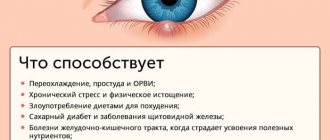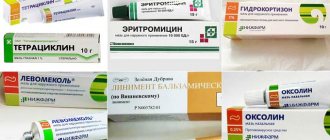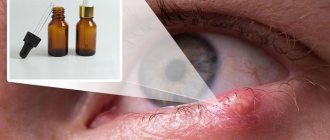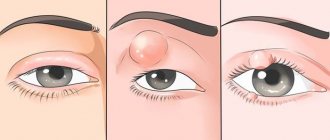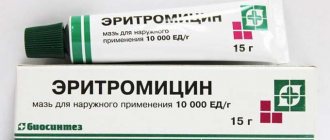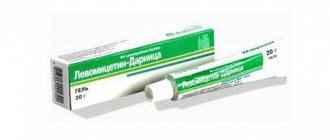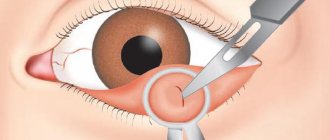Table of contents
- Causes of stye on the eye
- Types of barley
- Symptoms
- Stages of the disease
- How to treat stye
- How to treat stye on the eye in the initial stages
- How to treat barley in a child
- Complications of stye
- What to do if stye recurs frequently
What is stye on the eye? This is an inflammation in the eyelash bulb, which first looks like a small red swelling on the eyelid, and then can develop into an abscess with a transparent outer wall and yellow or white contents. Styes not only look repulsive, but also cause severe discomfort: itching and burning are felt in the affected area, pain appears when blinking or touching, and the person has an irritating feeling that there is a foreign object in the eye. If timely treatment is not started, stye may occur again and again or cause serious complications.
Application rules
When treating barley with liniments, you must strictly follow the instructions for use and follow the recommendations given by the doctor.
The rules for placing medicine are as follows:
- Before applying liniment or cream, wash your hands thoroughly with warm water and soap and dry them.
- Open the tube and squeeze 1 centimeter of medicine onto a special glass rod.
- Place the drug behind the eyelid.
- Close and roll your eyes for better distribution of the medicine.
- Keep your eyes closed for 5 minutes.
The drug is added or applied 2-3 times a day. But in some cases it is necessary to carry out the procedure 4-5 times.
If there is an external stye, it is not necessary to put the ointment behind the eyelid; external treatment will be sufficient.
Causes of stye on the eye
In 9 out of 10 cases, the cause of stye on the eye is a staphylococcal infection - for example, infection with Staphylococcus aureus bacteria occurs.
They live on the skin, in the hair, in the nose, in the intestines, in the throat. According to WHO, about 20% of the world's population is infected with this infection. Bacteria may not manifest themselves for a long time, but under certain conditions (general exhaustion of the body, eye diseases, etc.) they penetrate into the hair follicle of the eyelash or into the sebaceous gland of the Zeiss and cause inflammation. Also among the reasons why barley may appear on the eye are streptococcus and the parasitic demodex mite. Risk factors for developing stye are:
- weakened immune system;
- oily skin;
- hypothermia;
- neglect of hygiene rules;
- diabetes;
- blepharitis (inflammation of the edge of the eyelids);
- ·conjunctivitis;
- pathologies of the endocrine system;
- diseases of the digestive system;
- avitaminosis;
- immunodeficiency states;
- allergy;
- metabolic disorders;
- eyelid injuries;
- using cheap cosmetics and applying them with dirty tools.
Barley is usually called non-contagious. However, if the pus released from the opened capsule gets on the skin or mucous membrane of another person, there is a chance that he will also develop the disease.
What is barley
Barley is an acute inflammatory process that occurs in the eye area and affects the hair follicles of the eyelashes or the sebaceous glands.
Depending on the form and location of inflammation, various types of disease are distinguished. Styes may appear on the upper or lower eyelid, on the outer or inner side, in the corner of the eye.
In some cases, this abscess is confused with another similar formation - a chalazion. And unlike barley, chalazion is dense and painless to the touch, since in this case infiltrate accumulates under the skin, and the cause is blockage of the gland flow.
The main difference is that a chalazion is an encapsulated formation, so it is advisable to remove it surgically.
Types of barley
If you look at a photo of stye on the eye, it is noticeable that the abscess can be in the eyelash area or in the thickness of the eyelid. So there are 2 types of disease:
- External stye is an inflammation of the hair follicle at the edge of the eyelid. A mature abscess spontaneously comes out 3-4 days after the first symptoms appear.
- Internal stye is an inflammation of the glands on the inside of the eyelid. The abscess is opened from the side of the conjunctiva, also on the 3-4th day.
In most cases, barley causes one abscess. Multiple styes indicate a serious decrease in immunity and other systemic diseases, usually accompanied by high fever, weakness, and loss of appetite. It is necessary to immediately consult a doctor for diagnosis in order to identify the causes of the development of multiple barley and begin comprehensive treatment.
Symptoms and stages
Barley on the eyes, like all pathological processes, is characterized by several stages of development. Each stage has its own symptoms. For a general understanding, it is necessary to know how the disease develops in order to prevent hordeolum in the early stages.
Stage I - inflammation begins, the eye itches, redness and swelling appear in the affected area. Accompanied by general weakness, headache, fever. In some cases, the swelling is so severe that the stye in the eye prevents the eyelids from opening, even after antiseptic treatment.
Stage II - symptoms increase. The pain is excruciating, the eyelid is swollen, and a purulent capsule is forming in the eye. Outwardly, it resembles a small transparent swelling, with visible white contents.
Stage III - the abscess continues to increase in size until it independently breaks through into the external or internal environment, depending on the location. Sometimes it can reach an impressive volume, without breaking the capsule, which is opened only through surgery.
Stage IV - after the purulent capsule breaks through, a regenerative crust forms, which is the main sign of recovery.
At any stage of the disease, you should never squeeze out a “pimple” yourself. This can lead to an increase in treatment time and disastrous consequences, including blood poisoning. Pus through the mucous membranes can penetrate deep into the orbit, saphenous veins, and lymph nodes. As a result, the appearance of multiple abscesses of the eyelid, thrombosis of the vessels of the eyeball, due to the proximity of the brain, purulent meningitis, and sepsis, cannot be ruled out.
Symptoms
To understand that treatment for stye on the eye is required, you need to be sure that you are suffering from this particular disease. In addition to the main symptom - the appearance of a painful swelling on the eyelid that looks like a pimple - there are other signs:
- redness and swelling of the eyelid;
- increased lacrimation;
- pain when blinking;
- itching
If a person has a severely weakened immune system, the infection can manifest itself as fever, headaches, and enlarged lymph nodes.
What not to do
There are many more tips on how to get rid of stye on the eye. However, many of them are simply absurd. They were listened to in the old days, when medicine was poorly developed, and people did not think about the consequences that such “treatment” could lead to.
Previously, if inflammation began at the edge of the eyelid, they advised:
- Spit in the eye;
- Make a compress from urine;
- Instill breast milk;
- Heat already formed barley;
- Squeeze out the abscess.
We have already talked about the harm of compresses earlier - this will only help spread the infection, as is the case with squeezing out an abscess. Warming up barley at the stage of formation and maturation of the head leads to an increased risk of complications in the form of sepsis and meningitis.
Separately, we draw attention to the fact that instillation of any liquids into the eye, except those that have exceptional antibacterial and anti-inflammatory effects, is strictly prohibited. Saliva contains a lot of microbes that can cause other inflammatory eye diseases. And breast milk is an excellent breeding ground for bacteria. Urine can also be contaminated, and it also decomposes quickly, which will only worsen the development of stye.
Stages of the disease
To understand how to quickly cure barley, it is advisable to first understand how the disease progresses. There are 4 stages in total.
| Stage | How long does it last | Description |
| Infiltrative | 2-3 days | There is an itching sensation in the eyelid area, sometimes turning into a burning sensation. Redness and swelling appear. The eyelid is painful to touch. |
| Suppuration | 2-3 days | An abscess forms. It looks like a large round pimple. The head is whitish or yellowish. |
| Breakthrough | 1-2 days | The capsule ruptures on its own, or it is opened by an ophthalmologist or surgeon. After a breakout, pus may continue to ooze for several days. |
| Healing | 5-7 days | A crust forms on the eyelid. Gradually, new skin forms under it, and then the crust falls off. |
How to treat stye
Methods to combat infection differ depending on the stage of the disease. If anti-inflammatory and antibacterial treatment is prescribed at the initial stages, then at later stages, after opening the capsule, treatment with an antiseptic is necessary to prevent re-suppuration. Let's take a closer look at how to cure stye on the eye, depending on the progress of the disease.
How to treat stye on the eye in the initial stages
People with healthy immune systems can try to treat the disease in the early stages, when it manifests itself as redness and itching of the eyelid, as well as the sensation of a foreign body in the eye. It must be borne in mind that it is most likely impossible to avoid the appearance of an abscess if the infection recurs, as well as in the presence of chronic diseases of the immune and thyroid systems.
There are recommendations on how to cure barley in both traditional and folk medicine. We present the most effective methods.
- Dry heat. You can use warm (not hot!) objects that hold the temperature for a long time: salt wrapped in a bag, a boiled egg. UHF therapy will also help. It is very important to remember that this home method is only suitable for the first stage of the disease: if you apply heat to the abscess, you can significantly worsen the infection.
- Compresses. Be sure to use sterile materials (cotton wool, tampons, bandages). They are soaked in alcohol and water (1:1 ratio) or calendula decoction (1 tablespoon per 200 ml of water, prepared in a water bath). The compresses are left for 15-20 minutes.
- Wiping. They use a solution of “Furacilin”: it helps prevent the spread of infection and reduces inflammation. You can wipe your eyes at intervals of several hours.
- Eye drops for stye on the eye. You need to choose products with antibiotics. They are instilled 3 to 6 times a day to fight germs and prevent the process from spreading. The following medications will help with barley: “Albucid”, “Tobriss”, “Fucitalmic”, “Vigamox”, “Levomycetin”.
- Antibacterial treatment with ointments. It is necessary to reduce bacterial activity around the lesion. How to smear stye on the eye? Suitable eye ointments are: “Floxal”, “Maxidex”, tetracycline and gentamicin ointments, “Levomekol”, “Eubetal”, “Tobrex”. As a rule, they are placed at night, as they can reduce the quality of vision.
Since the development of the disease is greatly influenced by the state of the immune system, an important piece of advice on how to quickly cure stye on the eye would be to eat right, consume a sufficient amount of vitamins or add additional multivitamin complexes.
How to get rid of stye on the eye after an abscess appears
A capsule with pus, as a rule, appears on the 3-4th day and opens within a few days. After this has happened, it is necessary to remove the pus and take care to prevent re-suppuration. To do this, the wound is treated with iodine or brilliant green. You can also use drops: sodium sulfacyl solution, Furacilin and other drugs with antimicrobial effects.
If the capsule has not opened within 6-7 days, you need to go to the doctor. You should not look for how to remove stye from the eye yourself: the absence of a breakthrough means that the walls of the capsule are too dense; attempts to pierce it can lead to serious injury.
The doctor opens the capsule in a hospital or clinic setting. Local anesthesia may be used. As in the case of a boil or boil on the eye, the abscess is carefully opened, after which the doctor controls the separation of pus. If the patient has multiple stye or the disease does not recur for the first time in a short period of time, antibiotics may be prescribed in the form of tablets or powders. The most effective medicines for barley on the eye are Doxycillin, Ampicillin, Amoclav, Phleboclave, Azitrox, Sumamed. Most often they are taken within 5-7 days.
The best ointments for external and internal barley
There are many effective ointments that help quickly cure gordeolum. They are easy to find in any pharmacy. They are inexpensive. It is not recommended to prescribe medications for the treatment of hordeolum on your own; you should consult a doctor. Before prescribing a medicine, an analysis is required to determine the microorganism that caused the disease, and then an ointment is prescribed, which is based on an antibiotic that kills this particular pathogenic microflora. Otherwise, treatment may be useless.
Tetracycline
The most popular eye ointment used to get rid of stye. The active ingredient is the antibiotic tetracycline, which can destroy most harmful bacteria while simultaneously stimulating the immune system. The ointment has an antiseptic and anti-inflammatory effect due to the active component. Has a long lasting effect. Liniment based on tetracycline is used for external and internal use.
The drug must be placed behind the eyelid or applied to the external stye 3-5 times a day until the inflammation is completely eliminated. Tetracycline ointment for barley is used to cleanse the wound from the remains of dead particles when the abscess opens. Do not use the medicine if you are allergic to tetracycline.
Erythromycin
The antimicrobial liniment is based on the antibiotic of the same name. The ointment has long been used in ophthalmic practice due to the fact that it effectively copes with a large number of infectious pathogens. Erythromycin ointment will help get rid of internal barley and external hordeolum. It is placed behind the eyelid or applied to the external stye 3-5 times a day.
Synthomycin
A powerful antibacterial drug with anti-inflammatory effect. The main substance is chloramphenicol, which can disrupt the production of proteins by pathogenic microorganisms, killing them. Use Sintomycin twice a day. The duration of treatment with the drug is determined by the doctor in each case individually.
Do not use the ointment if you have: psoriasis, suppressed hematopoietic function, eczema. It is contraindicated for children under one year of age, during pregnancy and breastfeeding. As side effects, patients note the appearance of rashes, irritation of the skin and mucous membranes.
Hydrocortisone
Corticosteroid liniment, which contains the active component hydrocortisone (steroid). The ointment has an antihistamine, exudative effect, and effectively eliminates inflammation. Liniment is placed behind the eyelid or applied directly to the sore three times a day. The course of treatment is determined by the attending physician. Hydrocortisone ointment is not used in the presence of tuberculosis, eye trachoma, during pregnancy and breastfeeding. After its use, itching, redness, blurred vision, and increased fatigue are sometimes noted.
Vishnevsky (balsamic liniment according to Vishnevsky)
An effective and popular plant-based remedy perfectly eliminates inflammation, promotes rapid ripening of barley and its breakthrough. The composition contains an antiseptic component - xeroform, which destroys microbes, castor oil, which moisturizes and has an anti-inflammatory effect, and birch tar, which improves tissue nutrition. Vishnevsky's liniment is considered an excellent antiseptic, helps fight infection, but is not an ophthalmic drug. The drug is used only externally; with prolonged use, it can cause allergic reactions, severely irritating the skin.
Oxolinic
To get rid of hordeolum, use oxolinic ointment with a 0.25% concentration of the active substance, which is tetraxoline, which has an immunostimulating and antiviral effect. The medicine is placed in a thin strip under the eyelid or applied to the outer stye up to five times a day. Oxolinic ointment can cause rash, itching, burning, and hives.
Ichthyol
The active components of the drug are tar, ichthyol, resin, sulfur, which have an analgesic and antiseptic effect. Ichthyol ointment normalizes the tone of eye tissues and improves metabolism in them. In ophthalmic practice, a drug with a maximum concentration of the active substance of 10% is used.
Read in a separate article: Levomekol for barley on the eye: how to use correctly
Use the medicine only externally, as its contact with the mucous membrane of the eye can cause a burn. Ichthyol, which is part of it, has a warming effect. Apply liniment in a thin strip to the barley, without rubbing, three times a day.
Acyclovir
Antiviral ointment for eyes, which is based on the active substance - acyclovir. Additional components are: nipazole, nipagin, lipocomp. Acyclovir is a powerful anti-inflammatory drug, so only a doctor should prescribe it. Used for recurrent or advanced forms of barley. Apply under the eyelid 3-5 times a day. Treatment continues for at least a week, depending on the severity of the infectious process.
Levomycetinic
The active component of the medicine is chloramphenicol or chloramphenicol (antibiotic). It penetrates the cell membrane and blocks protein synthesis in bacteria, stopping their reproduction. When treating barley, one percent Levomycetin ointment is placed behind the eyelid or applied externally 3-5 times a day.
Phloxal
The bactericidal liniment Floxal, which is based on the antibiotic ofloxacin, destroys most gram-negative microorganisms. Helps with many ophthalmological processes in the eye structures.
For barley, Floxal is applied 2-3 times a day under or on the eyelid. The remedy against barley is not prescribed if you are intolerant to the components of the medicine and during pregnancy. It is possible to use Floxal drops and ointment at the same time.
Advantan
A bactericidal and antihistamine drug based on corticosteroids. Apply it exclusively to the outer side of the eyelid once a day. Do not use for more than 6 days due to the risk of developing allergies.
Advantan is approved for use even by newborns.
Levomekol
This combined antibacterial medicine has a detrimental effect on staphylococcal infections and E. coli. The active ingredient is chloramphenicol. Liniment is used as a compress on the eyes.
How to treat barley in a child
Barley in a child, unfortunately, is a common occurrence. Firstly, due to the fact that children and adolescents often neglect the rules of hygiene, and secondly, due to immature immunity. At the same time, young children often cannot articulate what is bothering them, so it is not possible to “catch” the infection in the early stages.
If there is a suspicion that a child has a stye on the lower or upper eyelid, it is advisable to see a doctor as quickly as possible: it is difficult to explain to the baby that you cannot rub your eyes, so the infection can quickly spread, including to the second eye. In addition, children have a tendency to relapse of the disease without comprehensive treatment.
You should start by monitoring hand hygiene and explaining in detail to your child why you should not touch your eyes. Regular wiping with Furacilin is mandatory. Antibacterial drops are used to treat styes on the eye; ointments are difficult to apply to a small eyelid. If your child's immune system is weakened, the doctor will also prescribe oral antibiotics.
“Not wheat and not rye”: what is stye on the eye and how to treat it?
Swelling on the eyelid resembles barley grain. This similarity formed the basis for the popular name of the disease. Barley is an unpleasant phenomenon, but to many it seems harmless. Is it necessary to be treated for it and what mistakes are important to avoid, says Olga Aleksandrovna Yakovleva, an ophthalmologist at the Expert Clinic Kursk.
— Olga Alexandrovna, what is barley?
— This is the name for an infectious-inflammatory disease of the eyelash bulb, which is caused by blockage of the sebaceous or meibomian gland of the eyelid. However, this name is not entirely scientific.
- What is another name for stye on the eye?
- Gordeolum. It is under this name that this disease is recorded in ICD-10.
— What are the reasons for the appearance of stye on the eye?
— There are many factors that lead to gland blockage and inflammation. Among them are external (environmental influences) and internal (endogenous, caused by the state of the patient’s body). It is difficult to single out one main reason. However, most often pathology is caused by weakened immunity and non-compliance with hygiene standards.
You can read more about immunity in our article
— Is it possible to get stye on the eye?
- No, this is impossible.
— What are the symptoms of stye on the eye?
— Symptoms characteristic of inflammation are noted: swelling, redness. In the first days, a person is bothered by pain. Then suppuration begins, when pus appears, the pain decreases. Also, many patients noticed that on the eve of the appearance of the “pea” they had a tingling sensation in the eyelid and itching.
— Why does recurrent stye occur in our eyes?
— The disease recurs if you do not maintain eyelid hygiene. This doesn't mean you need to wash your face every two hours. Hygiene also includes the environment in the building. And if a person works in a dusty room (this is a very common problem in production) or, for example, is constantly under air conditioning, the risk of relapse is very high. Relapses also occur during exacerbation of internal diseases, in particular chronic pathologies of the gastrointestinal tract.
— Olga Alexandrovna, could the appearance of stye indicate more serious health problems?
— Patients are not always ready to believe that the cause of barley and chronic blepharoconjunctivitis lies in diseases of the digestive system. However, there is a connection. In some cases, complex treatment is required, which involves a gastroenterologist or immunologist.
“Patients with conjunctivitis experience photophobia, lacrimation, and a sensation of a foreign body in the eye.” Quote from the material “What causes your eyes to turn red? How to properly treat conjunctivitis?
Also, pathologies of the paranasal sinuses can lead to frequent relapses. To exclude this factor, you should contact an otolaryngologist.
One of the diseases of the paranasal sinuses is sinusitis. You can find out more about it here
— Do I need to treat stye on the eye or can it go away without treatment?
— It is necessary to treat the inflammatory process. However, when self-medicating, it is important to avoid serious mistakes. Remember that no physiotherapeutic procedures can be performed for inflammation! Unfortunately, some people try to heat the sore area (using a boiled egg, a bag of sand, etc.). This folk method is very dangerous and often causes deterioration. Heat can cause pus to break out.
— What medications are usually used for stye on the eye?
— In modern medicine, an ointment with a fluoroquinolone antibiotic is used to treat gordeolum. Sulfonamides are also very effective: they have proven themselves long ago. In addition, we prescribe antihistamines in tablet form to reduce the risk of complications such as redness and swelling.
I cannot recommend a specific treatment regimen without seeing the patient. Each case is individual. For some, antibacterial drops are enough, while others need to add steroids and prescribe compresses.
During the recovery period, when there is no longer inflammation, UHF with hydrocortisone ointment has a positive effect. But only the attending physician should prescribe this physiotherapeutic procedure.
— Can a person cure stye on his own or is it always necessary to contact a specialist?
- At the first symptoms, self-medication is quite possible if the cause of the disease was poor hygiene. If the reason is unclear, it is better to consult a specialist. After all, barley can turn into chalazion - a chronic form that is much more difficult to cope with. Chalazion often requires surgical treatment.
— How else to separate situations when self-medication is acceptable from those in which you need to rush to the doctor?
— With self-medication, improvement should occur in 2–3 days. If not, go to the doctor.
Among the dangerous consequences of stye on the eye
chalazion (chronic form),
bacterial blepharoconjunctivitis,
cellulitis of the century
— What complications can stye on the eye lead to?
— Among the dangerous consequences are chalazion (chronic form), bacterial blepharoconjunctivitis, and phlegmon of the eyelid.
— What should be done to prevent barley?
— As I already said, it is important to observe the rules of eyelid hygiene. It is also necessary to maintain immunity and monitor the condition of the gastrointestinal tract. Women need to be careful when choosing cosmetics: cosmetics must be of high quality, and moreover, they can only be used individually.
You can make an appointment with an ophthalmologist here
ATTENTION: the service is not available in all cities
Interviewed by Daria Ushkova
The editors recommend:
How to use antibiotics correctly? Instructions for use
Your immune system is under control! We create a strong rear for the child
What does MRI of the eye orbits reveal?
For reference:
Yakovleva Olga Alexandrovna
In 2021 she graduated from Kursk State Medical University with a degree in General Medicine.
In 2021, she completed an internship in the specialty “Ophthalmology” and advanced training in the field of “Occupational Pathology”.
Works as an ophthalmologist at the Expert Clinic Kursk. Receives at the address: Karl Liebknecht St., 7.
Complications of stye
Stye on the eyelid is dangerous because it has very serious complications. If the patient’s immunity is strong, then the disease can go away on its own, even without the use of medications. But when the body is exhausted, barley not only recurs, but can also lead to dangerous conditions.
- Purulent conjunctivitis. If you do not maintain eye hygiene and do not use antibacterial ointments and drops, the infection will spread to the conjunctiva.
- Chalazion. This is a condition when a cyst forms in the thickness of the eyelid, in the meibomian glands. In the photo, stye and chalazion may look similar, but the treatment methods are different: the cyst often has to be eliminated with injections or surgery.
- Phlegmon of the orbit. This is a purulent inflammation of the orbital tissue, which is accompanied by severe pain, fever, swelling of the eyelids and can lead to decreased vision.
- Thrombophlebitis of the vessels of the eye. This is the name for bacterial inflammation of the venous wall. It is affected by an infection that has spread from barley, which leads to redness of the eyes, hemorrhages, changes in the fundus of the eye, and decreased visual acuity.
- Meningitis. This is a deadly disease that leads to coma, epileptic seizures, loss of vision and hearing. Meningitis usually develops against the background of orbital phlegmon, since the structures of the eye are located in close proximity to the lining of the brain.
What to do if stye recurs frequently
Frequently recurring stye signals the presence of more serious diseases. In this case, doctors recommend undergoing a full examination of the body to identify problems with the thyroid gland, immune system, and housing and communal services. For example, regular eye infections in children may be caused by problems with digestion. The most common cause of recurrent styes in adult patients is diabetes mellitus.
To make an accurate diagnosis, the doctor will prescribe a diagnostic test. It must include a general blood test, a blood test for glucose, HIV, hepatitis, and an analysis of intestinal microflora. If the barley is in the acute stage, a scraping is taken to determine the causative agent, an antibiotic sensitivity test is performed, and eyelashes are examined for damage by demodex mites.
Here are the basic methods on how to remove stye and prevent the disease from returning.
- Taking adequate medications aimed at a specific type of bacteria.
- Timely diagnosis and treatment of any eye diseases, from conjunctivitis to mite damage to eyelashes.
- Balanced diet.
- Taking vitamins.
- Rejection of bad habits.
- Regular rest.
- Physical activity by age.
- Controlling blood sugar levels.
- Strengthening immunity with immunomodulating drugs.
The main secret to quickly treating stye is a timely visit to an ophthalmologist. The sooner therapy is prescribed, the higher the chances of curing the disease without the formation of an abscess.
Prevention
To prevent stye from appearing again, you need to prevent bacteria from getting into the eye and maintain high immunity. After all, it will not be possible to completely eliminate contact with pathogenic microflora, but it is quite possible to strengthen the body’s defenses so that inflammation does not begin after just a few microbes enter the eye.
To prevent stye:
- Wash your hands after any dirty work and after going outside;
- Use personal hygiene products and cosmetics (handkerchiefs, towels, creams, mascara and eye shadow);
- Do not contact sick people;
- Prevent colds (take antiviral drugs during mass outbreaks of acute respiratory viral infections and influenza, ventilate rooms, maintain a high level of humidity in them and get vaccinations in a timely manner);
- Lead a healthy lifestyle (give up bad habits, eat right and move more);
- Treat emerging diseases in a timely manner.
The development of stye can be prevented before an abscess begins to form. But for this you must be able to accurately determine the first signs at an early stage of the disease from the beginning of head maturation. Try to start treatment as soon as symptoms of inflammation are detected. And then you can avoid the ripening of the abscess and cure the disease in just 1-2 days.


